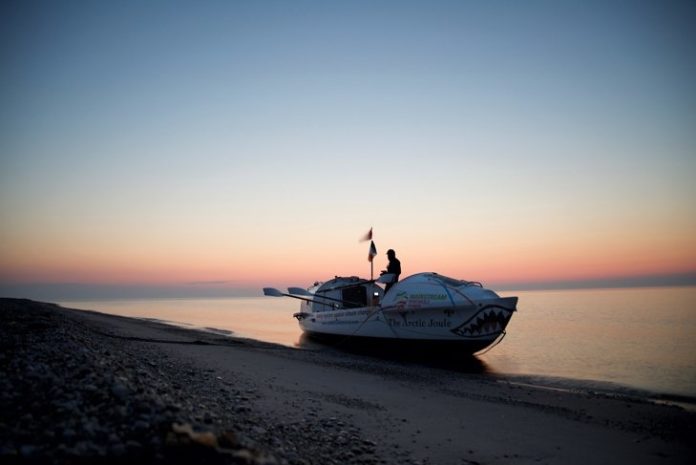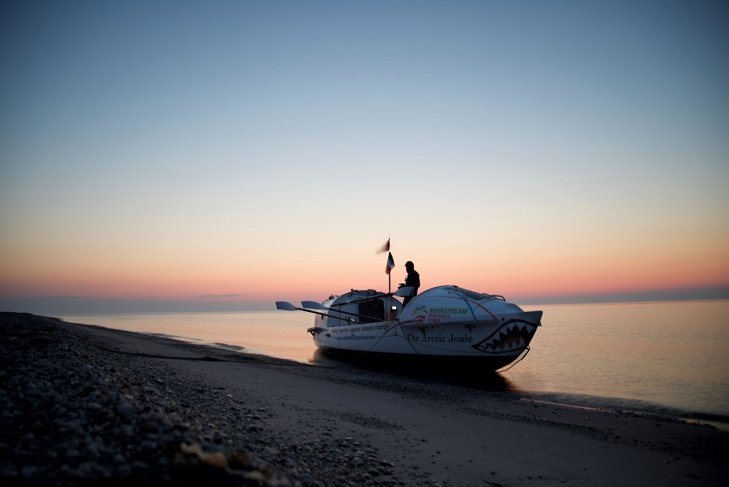
“If one could make it across the Northwest [Passage] in a single season, in a rowboat, it would scream to the profound effects climate change is having on the Arctic,” writes Kevin Vallely in the opening pages of his new book, Rowing the Northwest Passage: Adventure, Fear and Awe in a Rising Sea (Greystone Books, 2017).
I recently spent a couple of rainy Vancouver afternoons reading Rowing the Northwest Passage: Adventure, Fear and Awe in a Rising Sea (Greystone Books, 2017). The title intrigued me because I love to row—on a normally serene and protected inland waterway—and I’m also a committed tree hugger. This story captivated my attention because of the sheer audacity of the “adventure.”
The author, Kevin Vallely, is an architect (recipient of a Royal Architectural Institute of Canada Medal and Commonwealth Scholarship in Architecture to Cambridge University, England), adventurer, husband, father of two girls, and an avid proponent of balance in life.
He has been recognized by the Explorers Club and was an Explorers Club Flag recipient (#81) for the traverse of the Northwest Passage that he describes in his book.
Vallely, a life-long adventurer and endurance athlete who already had a record-breaking 700 mile (1,130 km) trek to the geographic South Pole along with an impressive list of other adventures under his belt, turned his attention to the north in 2012.
He had been fascinated with the Arctic since listening to his father’s stories of time spent on the northern Labrador coast. Then he saw An Inconvenient Truth, Davis Guggenheim’s documentary of Al Gore’s campaign to bring global warming to the public’s attention.
It wasn’t a huge leap for a wilderness explorer to recognize an opportunity to focus attention on the climate issue by using a daring expedition to make it oh so real. As he says in his book, “If one could make it across the Northwest [Passage] in a single season, in a rowboat, it would scream to the profound effects climate change is having on the Arctic.”
The next steps were to pull together a team, commission a boat, secure a sponsor, craft a plan for rowing the Northwest Passage, and learn the basics of rowing.
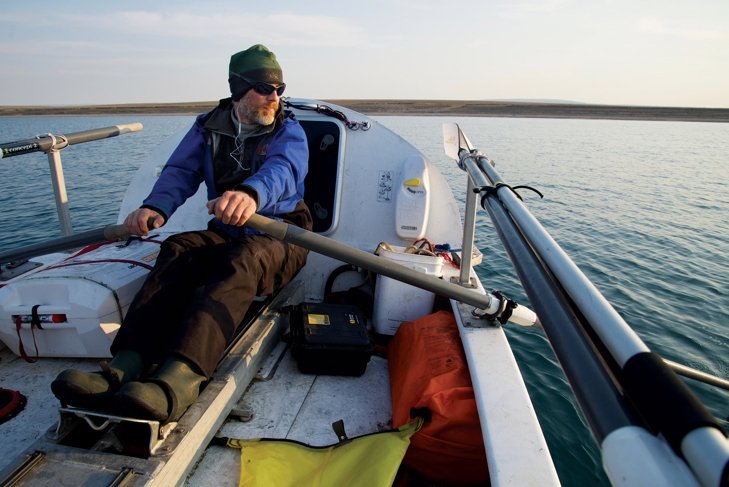
The basics of rowing, indeed!
As I well know, rowing (sculling), as a sport, requires very technical skills. Vallely says, “We had only the basics of sculling down. We didn’t feather at all (a motion that turns the blades parallel to the water to avoid splashing) and didn’t overlap our hands for fear of injury.”
Little more than a year later, on a warm day in Inuvik, Northwest Territories, four men in a fully equipped one-ton sea-going boat (whose only commonalities with the sculls I row are the slides, rolling seats, and oarlocks) launched, starting what would be a 54-day, 1,163 mile (1,872 km) voyage.
How much can a rigged rowing boat weigh?
In my sport of rowing, a men’s heavyweight four-man rowing scull weighs between 56 and 58 kg (123 and 128 lb). The Arctic Joule tipped the scales at 1,200 kg (2,645 lb).
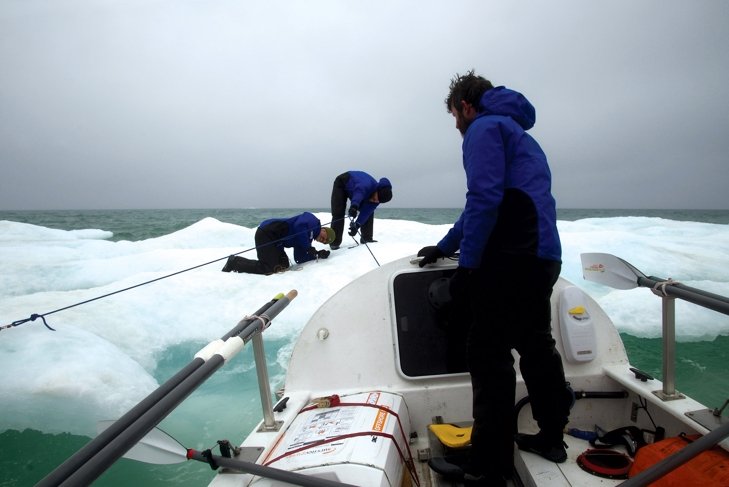
The journey began peacefully enough, but the crew was soon wishing for the irritating mosquitoes that quiet waters bring—instead of the challenges presented by howling northeasterly winds, broken anchors, or one of the many side trips into less than ideal, but safer moorings in rocky inlets.
These side trips were often long, giving them a chance to become familiar with the Inuit concepts of quinuituq and ilira.
Quinuituq, best translated as deep patience, can be compared to the notion of a great white bear waiting at a seal hole for its prey to surface.
Ilira, which has no English equivalent, conveys the same sense of fear that accompanies great awe, the kind of awe referenced in the book title.
Ilira came to define their journey, with its ever-changing seas, sudden encounters with beluga whales and erect brown bears, and multi-ton masses of sea ice threatening to devour their small craft.
And as Vallely dryly says in his book, as the adventurers face a harrowing encounter with poor visibility, high winds, “house-sized rollers,” and approaching pack ice, “it becomes obvious … that facing backward in a rowboat can be very impractical at times.”
Vallely’s telling of his Arctic adventure is juxtaposed with the more urgent message of environmental change.
- Elders describe permafrost melting away and taking the land with it.
- Bad winds that once came from the northwest now blow out of the northeast.
- Magpies and squirrels inhabit worlds they previously could not access.
- Polar bears are stranded onshore.
- Bays that were previously frozen in early October no longer have ice.
- And berries are still ripe for the picking in September.
Equally compelling is a comprehensive but easily grasped explanation of the critical role sea ice plays in moderating the global climate (the long term, measured in decades), and how its decline has contributed to increasing unpredictability in weather (a short-term local phenomenon).
For Vallely, the takeaway from his adventure is simple: listen to the voice of the Arctic people, those who are first-hand witnesses and have no agenda, unlike the lobbyists and naysayers who tend to “cherry-pick” their science.
For this author, “climate science is not a belief system, but cold hard data.” He continues to speak publicly about his journey and promote his book, walking his talk in life.
His last big adventure was a family paddle down the Mackenzie River. As for that life balance, he works from home, refusing to sacrifice family life, and willingly “drops something” when things get out of kilter.

The tortured form of a decaying piece of ice glides past us and disappears again into the fog, a weary foot soldier returning home from some distant battle. The hair-raising action of the last couple days has frayed our nerves, and rowing our boat blindly around the Arctic headland of Cape Parry between large chunks of ice isn’t helping. The wind died at two-thirty this morning when a cold, stagnant Arctic air mass took its place and we jumped at our opportunity to move. This is the first calm weather we’ve experienced in days, and we treat it as a change in our fortunes. We couldn’t be more wrong.
It’s July 31, 2013, as Frank Wolf and I are rowing our four-person ocean rowing boat, the Arctic Joule, through the waters of the Amundsen Gulf on the Northwest Passage. Our teammates, Paul Gleeson and Denis Barnett, are resting in the stern cabin awaiting their turn on the oars. The visibility is a mere fifty yards, but we’re forced to travel solely by the aid of GPS and compass. We know we’re close to the cape from the steady thump of waves against cliff, but we see nothing.
The seas change as we round Cape Parry, with house-sized rollers, dark and foreboding, rising out of nowhere, sweeping beneath our hull and disappearing again into the murk. The rhythm of the swell is like the deep breathing of some oceanic giant rousing from its slumber, the crash of wave on rock its wake-up call.
We rise and fall with the pulse of the ocean, but we’re blind in this world of white. The steady rumble of surf to starboard helps us navigate, and the sound of breaking waves feels ominous. It’s not long before the echoes from the cape begin to surround us—one moment to starboard, then to port, then back to starboard again—and we become completely disoriented. “We need to get away from these cliffs,” I yell to Frank.
“It’s too dangerous this close to the cape.” The sound of breaking waves envelops us. “We’re spinning in circles,” Frank says after checking the GPS. “We’re caught in a current or something.”
We try everything to right ourselves, but it’s hopeless; our boat is gripped by an invisible force and we can’t regain control. In the confusion we fail to notice the building wind until it explodes upon us, driving us straight out to sea. Just offshore, about six miles away, sits the pack ice, and we’re now headed straight for it. If we reach it, we’ll be crushed.
I clamber into the cabin and check the navigation screen of our onboard GPS. I wonder if we have space to outrun the pack ice if we fight the wind and head south. The pack ice is big, the winds are intensifying, and we don’t have control of the boat.
“Not likely,” I mumble. As I stare blankly at the navigation screen, I see it. I hadn’t noticed it earlier on the handheld GPS, but there appears to be an island between us and the pack. Called Bear Island, it’s a mere speck, maybe a hundred yards wide, but if we can make it there, we might save ourselves. It’s our only chance.
We hold a straight line going southeast, 45 degrees to the wind-driven waves, and start rowing for all we’re worth. The seas continue to build and the fog remains thick. The waves are hitting us hard to starboard as we battle cross seas to a point several miles upwind from the island and make our turn. The scream of the wind dies immediately and we start to glide with it. “It’s like landing a paraglider on a postage stamp,” Frank says, the only words we’ve shared in the last thirty minutes. Surfing among the white-capped rollers, we race toward our invisible island in the fog.
When we’re within a mile or two, I scream to Paul and Denis to get out on deck. “Put on your dry suits, guys!” They scramble out of the cabin, fully aware of what’s been unfolding.
“Tell us when you see the island,” I shout. It becomes obvious now that facing backward in a rowboat can be very impractical at times.
“We’re four hundred meters out,” Frank yells (about four hundred yards), “Do you see anything?”
“Nothing,” Paul replies.
A moment later, Frank yells, “Two hundred meters out.”
“Nothing,” Paul says. “Wait a moment, I think I see—”
We all hear it before we see it—the deep, resonating thud of wave against cliff. I strain my neck over my left shoulder to see Bear Island ringed in steep cliffs, huge waves, and little hope. Our island refuge is no salvation at all.
Excerpt from Rowing the Northwest Passage: Adventure, Fear and Awe in a Rising Seaby Kevin Vallely, published September 2017 by Greystone Books. Excerpt first published on canadiangeographic.ca in September 2017. Condensed and reproduced with permission from the publisher.
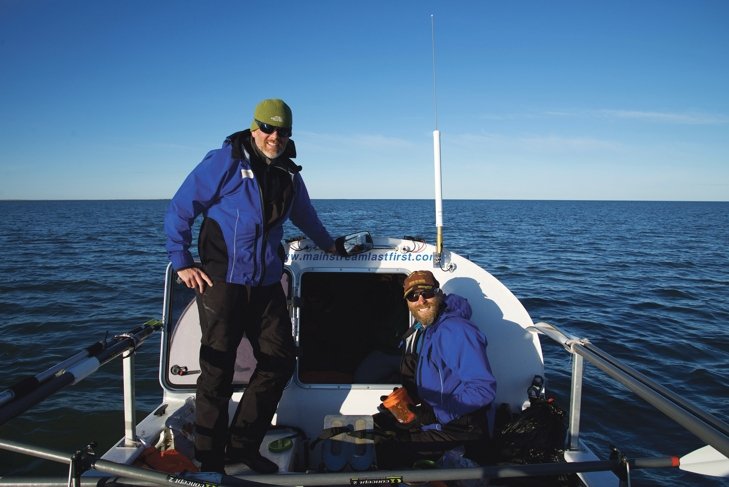
In case you’re thinking you’d like an ocean row …
The Arctic Joule is for sale: “Ocean rowing design … built specifically for an Arctic expedition … but ideal for an ocean row … fully equipped with extensive onboard equipment” … and no work required … “boat is ready to go.”
My take
Rowing the Northwest Passage is well worth the read. A bit choppy in the first chapters, it settles into an engaging first-person chronicle once the Arctic Joule has launched. A map would have helped to illustrate the journey, its detours, and the unplanned emergency stopovers; and a bibliography of additional readings could have added to the urgency of the message.
Nevertheless, this is a great addition to the reading list of anyone interested in climate change; the Arctic, its people, and the Northwest Passage; rowing; or adventure in general.


